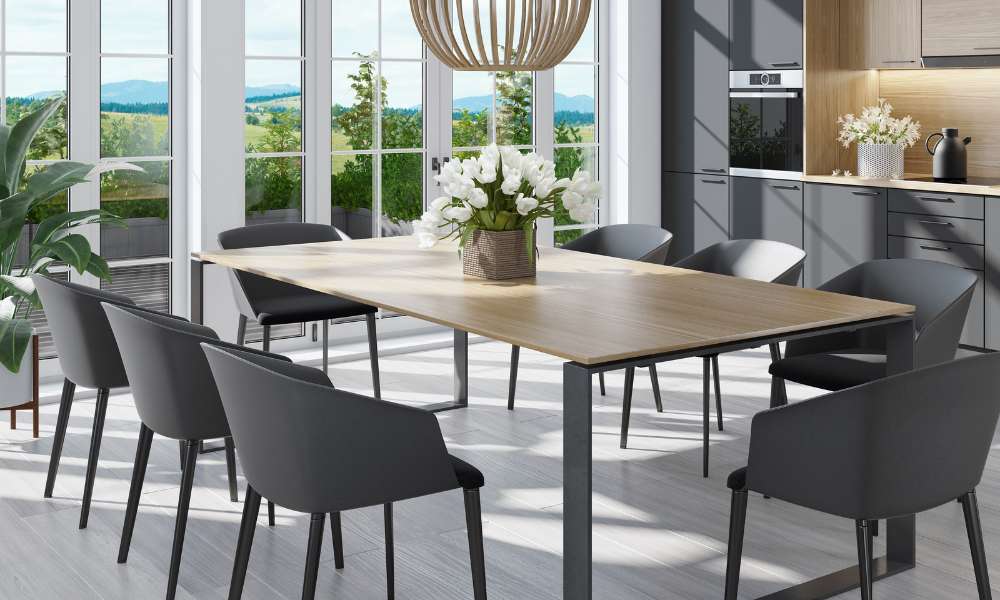Determining the optimal height for a dining room table is essential to creating a comfortable, functional, and stylish dining area. “How Tall is a Dining Room Table?” is a common question for anyone setting up a new dining space or upgrading their current furnishings. In this guide, we will explore the various standard heights for dining tables and their impact on your dining experience. From traditional setups to modern, multi-functional spaces, understanding the height of your dining table is crucial to ensuring it fits well with your lifestyle and aesthetic preferences. Let’s delve into the factors that influence dining table height and how to choose the perfect one for your home.
2. Standard Heights of Dining Room Tables
The standard height for a dining room table typically ranges between 28 and 30 inches. This measurement is optimized for use with standard dining chairs, ensuring comfort and ease of use during meals. In contrast, counter height tables stand taller, usually around 34 to 36 inches, pairing well with counter stools and creating a more casual dining atmosphere. Bar height tables are even higher, generally measuring between 40 and 42 inches, suitable for bar stools, and ideal for creating a dynamic, social environment in your snacking space. These variations in desk heights not only accommodate different seating styles but also influence the dining experience.
A standard-height table facilitates formal meals and lengthy dinners, while counter and bar-height tables lend themselves to more casual encounters and social gatherings. Choosing the right desk elevation can profoundly affect the ambiance and functionality of your snacking area, shaping how comfortably and interactively you and your guests can engage during meals.
3. Factors Influencing the Choice of Table Height
Several factors play pivotal roles in determining the ideal table height for this room. First, the size and layout of the room are crucial considerations; a larger space might accommodate a taller table, like a bar height, which can serve as a focal point, whereas a smaller dining area might benefit from a standard-height desk to maintain a sense of openness and flow.
Functionality is another key aspect; depending on whether the desk is primarily used for everyday meals, as a workspace, or for multifunctional purposes, the height can significantly impact its usability and comfort. For instance, a standard-height table might be preferable in a setting where meals and homework are routine, offering ergonomic comfort for varied activities.
Finally, compatibility with other furniture, such as chairs and surrounding decor, is essential to ensure a cohesive look and functional experience. The height of the desk should harmonize with the chair heights to provide a comfortable seating arrangement that complements the overall aesthetics of this room décor. Selecting the right table elevation with these factors in mind will not only enhance the utility and appearance of your snacking space but also ensure it meets the diverse needs of your household.
4. Customizable Options for Table Height
For those seeking versatility and adaptability in their dining arrangements, customizable desk height options offer an excellent solution. Adjustable elevation tables, equipped with mechanisms that allow the tabletop to be raised or lowered, provide a range of benefits. They can easily transition from a comfortable height for seated meals to a counter height for standing gatherings, making them perfect for homes that host a variety of events. Additionally, for snacking spaces with unique dimensions or specific design needs, custom-built tables can be crafted to fit exact specifications.
These made-to-order pieces ensure that every aspect of the snacking area is maximized for both function and style, accommodating unusual room layouts or special decor themes. By opting for adjustable or custom-built tables, homeowners can create a dining environment that is not only functional and stylish but also perfectly tailored to their lifestyle and entertainment needs.
5. Ergonomics of Dining Table Height
The ergonomics of dining table height play a critical role in ensuring comfort and promoting good posture during meals. The ideal desk elevation for most adults is between 28 and 30 inches, which aligns well with standard chair heights of 18 inches. This setup helps maintain an ergonomic posture, reducing the strain on the back and neck by allowing the arms to rest comfortably on the desk without hunching over.
Proper table height is essential as it affects how comfortably individuals can sit and move their legs under the table. It also influences the ease with which diners can interact with their meals and each other. Insufficient legroom or a desk that is too high can lead to discomfort, making dining a less enjoyable experience. Therefore, ensuring that this table and chairs are proportionately aligned is not only crucial for aesthetic harmony but also for enhancing the overall dining ergonomics, promoting a healthier seating arrangement that can be sustained comfortably for longer durations.
6. Design Trends and Table Heights
Dining table heights have seen a variety of trends influenced by modern design innovations and changing lifestyle needs. Contemporary trends often challenge the traditional heights, introducing mid-century modern pieces with slightly lower profiles and minimalist designs that favor clean lines and less bulk. These modern tables subtly shift standard height measurements to create more open, spacious dining areas that cater to a relaxed, casual dining experience.
Additionally, the integration of industrial elements like adjustable crank mechanisms reflects a trend towards more flexible, functional furniture, allowing users to tailor desk elevation to specific activities or personal preferences. The role of design aesthetics in choosing desk height has become increasingly significant, as the height not only needs to meet functional requirements but also complements the overall interior design theme. Whether the goal is to create a striking visual impact with a tall, elegant bar table or to foster a welcoming atmosphere with a classic standard-height desk, the choice of table elevation is integral to achieving the desired ambiance and style of the dining space.
7. Maintenance and Care Tips for Dining Tables
Maintaining dining tables of various heights requires a careful approach to ensure their longevity and aesthetic appeal, regardless of the material or design. Regular cleaning with appropriate cleaners for the specific material—whether wood, metal, or glass—is essential. Avoid using abrasive or harsh chemicals that can damage the table’s finish. For wooden tables, using coasters and placemats can prevent water rings and heat damage, while for glass tables, microfiber cloths are ideal for avoiding scratches during cleaning.
Additionally, it’s important to periodically check and tighten any loose screws or hardware, especially in tables with adjustable features to ensure stability. Protecting your desk from direct sunlight can prevent fading, and using table pads during meals or activities can safeguard against scratches and spills. By adhering to these maintenance tips, you can protect this table regardless of its height or material, keeping it as a centerpiece in your dining area for years to come.
Conclusion
Selecting the right dining table height is more than just an aesthetic decision; it is a crucial element that affects the functionality, comfort, and overall ambiance of your dining space. Understanding the standard heights and how they compare to counter and bar heights can help you make an informed choice that suits your lifestyle and dining needs. Moreover, considering factors like room layout, intended use, and compatibility with other furniture ensures that this table is not only a beautiful addition to your home but also a practical one. With the right care and maintenance, your dining desk can serve as a welcoming gathering place for meals and memories for many years to come. Embrace the trends and customizable options available, and let this table elevation reflect your style and ergonomic needs.





